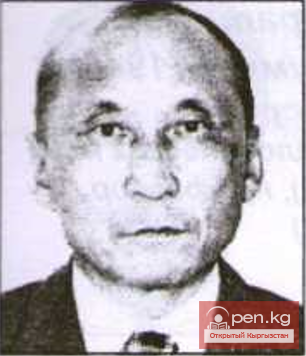
Chorotegin (Choroев) Tynchtykbek Kadyrmambetovich (1959), Doctor of Historical Sciences (1998),...

The project "USAID Business Development Initiative" (BGI), within the tourism...

Species of higher plants removed from the "Red Book" of Kyrgyzstan (1985) Species of...

Poet and prose writer M. Seitaliev was born in the village of Uch-Emchek in the Talas district of...

Prose writer and critic D. Kazakbaev was born on June 20, 1940, in the village of Dzhan-Talap,...

Sheriev Zheenaly (1932-2002), Candidate of Philological Sciences (1970), Professor (1991) Kyrgyz....

Zhorobekov Zholbors (1948), Doctor of Political Sciences (1997) Kyrgyz. Born in the village of...

Karymshakov Rakhym Karymshakovich (1936), Doctor of Physical and Mathematical Sciences (1995),...

Poet B. Sarnogoev was born on January 14, 1932, in the village of Budenovka, Talas District, Talas...

Salamatov Zholdon (1932), Doctor of Physical and Mathematical Sciences (1995), Professor (1993)...

Kenesariyev Tashmanbet (1949), Doctor of Historical Sciences (1998), Professor (2000) Kyrgyz. Born...

Osmonov Anvar Osmonovich (1941), Doctor of Veterinary Sciences (2000) Kyrgyz. Born in the village...

Critic, literary scholar, poet K. Artykbaev was born in the village of Keper-Aryk in the Moscow...

Omuraliyev Ashymkan (1928), Doctor of Historical Sciences (1975), Professor (1977) Kyrgyz. Born in...

Poet K. Tashbaev was born in the village of Shyrkyratma in the Soviet district of the Osh region...

Zakir Saparbek (1931-2001), Candidate of Philological Sciences (1962), Professor (1993) Kyrgyz....

Usubaliev Beishenbay Shenkievich (1954), Doctor of Philological Sciences (1994) Kyrgyz. Born in...

Poet K. Akaev was born on November 7, 1919—May 19, 1982, in the village of Kyzyl-Suu, Kemin...

Oskon Osmonov Jusupbekovich (1954), Doctor of Historical Sciences (1994), Professor (1996) Kyrgyz....

Poet and prose writer T. Miyashev was born in the village of Papai in the Karasuu district of the...

Poet M. Bularkieva was born in the village of Kozuchak in the Talas district of the Talas region...

Poet, critic, literary scholar O. Sooronov was born in the village of Gologon in the Bazar-Kurgan...

Suvanbekov Jursun (1930-1974), Doctor of Philological Sciences (1971) Kyrgyz. Born in the village...

Poet S. Dzhusuev was born in the wintering place Kyzyl-Dzhar in the current Soviet district of the...

Ishkeyev Nazarkul (1955), Doctor of Pedagogical Sciences (1995), Professor (1996). Kyrgyz. Born in...

Critic and literary scholar A. Akmataliev was born on January 15, 1956, in the city of Naryn,...

Insect species listed in the 2004 IUCN RLTS, not included in the Red Book of Kyrgyzstan 1....

Prose writer, journalist Dzh. Saatov was born on February 15, 1930, in the village of Alchaluu,...

Mamytov Jumash (1935), Candidate of Philological Sciences (1967), Professor (2001) Kyrgyz. Born in...

Poet T. Adysheva was born in 1920 and passed away on April 19, 1984, in the village of...

Kudaybergenov Torobai Turgunbekovich (1948), Candidate of Chemical Sciences (1985), Professor...

Zakirov Dzheenbek (1940), Doctor of Medical Sciences (1997), Professor (2001) Kyrgyz. Born in the...

Poet S. Urmambetov was born on March 12, 1934, in the village of Toru-Aigyr, Issyk-Kul District,...

Karashev Tashmat (1932), Candidate of Physical and Mathematical Sciences, Professor (1992) Kyrgyz....

Poet M. Akimkodzhoev was born in the village of Bazar-Turuk in the Jumgal district of Naryn region...

Raimbekov Dokturbek (1948), Doctor of Veterinary Sciences (1995), Professor (1996) Kyrgyz. Born in...

Bekboev Askarbek Abdykadyrovich (1956), Doctor of Philosophy (2002) Kyrgyz. Born in the village of...

Poet S. Abdykadyrova was born in the village of Sary-Bulak in the Kalinin district of the Kirghiz...

Prose writer and poet J. Mavlyanov was born in the village of Renzhit (now the village of...

Poet G. Momunova was born in the village of Ken-Aral in the Leninpol district of the Talas region...

Ashirbaev Toktosun (1948), Doctor of Philological Sciences (2001). Kyrgyz. Born in the village of...

Prose writer K. Osmonaliev was born on March 5, 1929, in the village of Chayek, Jumgal district,...

Poet and art critic S. Asanbekov was born in the village of Aral in the Talas region of Kyrgyzstan...

Dzholdoshbekov Abdykerim (1935), Candidate of Philological Sciences (1969), Professor (2001)....

Baygaziev Sovetbek Orozkanovich (1946), Candidate of Philological Sciences (1984), Professor...

Approved by the resolution of the Government of the Kyrgyz Republic dated February 20, 2012 No. 120...